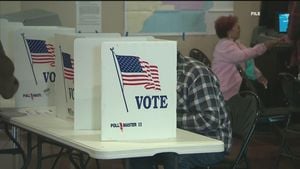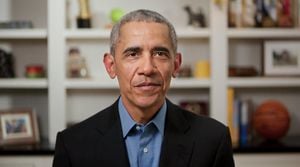The stage is set for the 2024 U.S. presidential election, and the economic plans put forth by both candidates, Vice President Kamala Harris and former President Donald Trump, are taking center stage. Each campaign is not only focusing on traditional political appeal but also honing their strategies to address the economic concerns of the electorate as the contest heats up.
Recently, Trump delivered a speech at the Detroit Economic Club, where he proposed making the interest on auto loans tax-deductible. This announcement is part of his broader tax cut strategy aimed at reviving the auto industry and stimulating the economy. Trump described his economic vision as paving the way for a "renaissance" within the automotive sector, expressing confidence it would lead to affordable car ownership for American families. "This will stimulate massive domestic auto production," he proclaimed, hinting at tariffs he believes would protect and bolster the domestic manufacturing environment against foreign competition.
Interestingly, Trump's plans also include raising tariffs on imports, particularly targeting vehicles manufactured by competitors like China. He stated emphatically, “I will impose whatever tariffs are required: 100 percent, 200 percent, 1,000 percent.” These tariffs, he suggested, would help create more space for U.S. manufacturers, reigniting the American automotive industry at what he perceives to be its peak potential.
Adding to the complexity of his economic proposals, Trump also mentioned ending what he described as "double taxation" for Americans living abroad. His agenda hints at tax breaks not just for auto loans but also for overtime pay and Social Security benefits. While his supporters view these proposals as pathways to economic revival, critics argue they might inflate the federal deficit significantly.
On the opposing front, Kamala Harris is launching her own economic strategy, aiming to showcase her agenda as more sustainable and equitable. Harris has made significant strides by introducing plans to improve Medicare. Specifically, she has proposed creating home care benefits to support elderly and disabled individuals who require long-term care. This initiative is particularly aimed at shifting the current caregiving burden from families to the healthcare system, addressing the plight of unpaid and underpaid caregivers who predominantly are women. "We need to build back the economy to support our families and the workers caring for them," she stressed during her recent speeches.
Harris argues her approach is necessary to reflect demographic shifts—specifically, the aging population triggering increased demand for caregiving services. Currently, many individuals rely on out-of-pocket payments, leading to unsustainable financial burdens. Under her proposed system, Medicare would provide coverage for home care, thereby alleviating some economic pressure off families.
With the consumer price index showing slightly higher inflation rates, Harris's campaign tactically seeks to frame the economic discourse by acknowledging the hardships Americans face, particularly with prices for essentials such as food and housing. Harris’s emphasis on wage growth—outpacing inflation which is currently at 2.4%—aims to connect her narrative to the everyday realities faced by voters.
Meanwhile, Trump's economic narrative showcases stark criticism of Harris’s policies, hinting they could lead to higher consumer costs. His campaign's stance often presents the economy not only as the main topic of debate but also seeks to paint the current administration's efforts as ineffective. He has leveraged this narrative whilst engaging directly with constituencies concerned about job security and costs associated with living.
The dynamic shifts observed during their public events shed light on each candidate's audience engagement. Harris's interactions at town halls often reflect her efforts to reach out to diverse voter segments, including Hispanics at dedicated Univision events. Trump, on the other hand, adopts more direct attack lines against Harris, occasionally dismissing the effectiveness of her proposals, which he refers to as overly complex and disconnected from reality.
Recent fundraising reports show Harris has raised over $1 billion since declaring her candidacy, indicating substantial backing for her economic and health care plans. This financial surge not only reflects her popularity but also showcases the Democrats' strategic focus on key battleground states, aiming for substantial outreach efforts through advertisements and field offices.
Trump’s campaign, too, is known for its aggressive fundraising tactics, with substantial contributions set aside to support his many tax cut proposals should he reclaim the presidency. Recent analyses indicate variations within their economic platforms, with some projecting Trump's proposals could incur more than $7 trillion to the federal deficit over ten years—a staggering number echoing concerns from both sides of the aisle.
Despite the contrasting economic narratives, one constant remains: both candidates present their strategies as pathways for recovery and growth after what many believe was exacerbated by the COVID-19 pandemic. Yet, each must navigate complex voter sentiments and historical economic indicators to effectively garner support as the election draws near. Harris's reiteration of her administration's achievements and Trump’s nostalgic pull back to purported economic prosperity form the crux of the electoral battle, and with just weeks left until the polls close, the final push will likely hinge on who can convince undecided voters of their economic vision's viability.
It's also worth noting the importance of voter engagement campaigns on social media platforms, where narratives are often shaped and reach rapidly shifts across demographics. Grassroots movements underpinning both candidates’ strategies, reflecting widespread discontent and calls for transparency and accountability from those seeking office.
The economy has undeniably become central to the electoral debate, forcing candidates to squarely address the public's pressing concerns. How they articulate their plans and respond to public scrutiny will significantly influence their paths to Election Day.
With debates dwindling and speeches proliferous, the political stage is heightening, leaving only one question: which economic vision resonates more with the American public as they prepare to cast their ballots?



